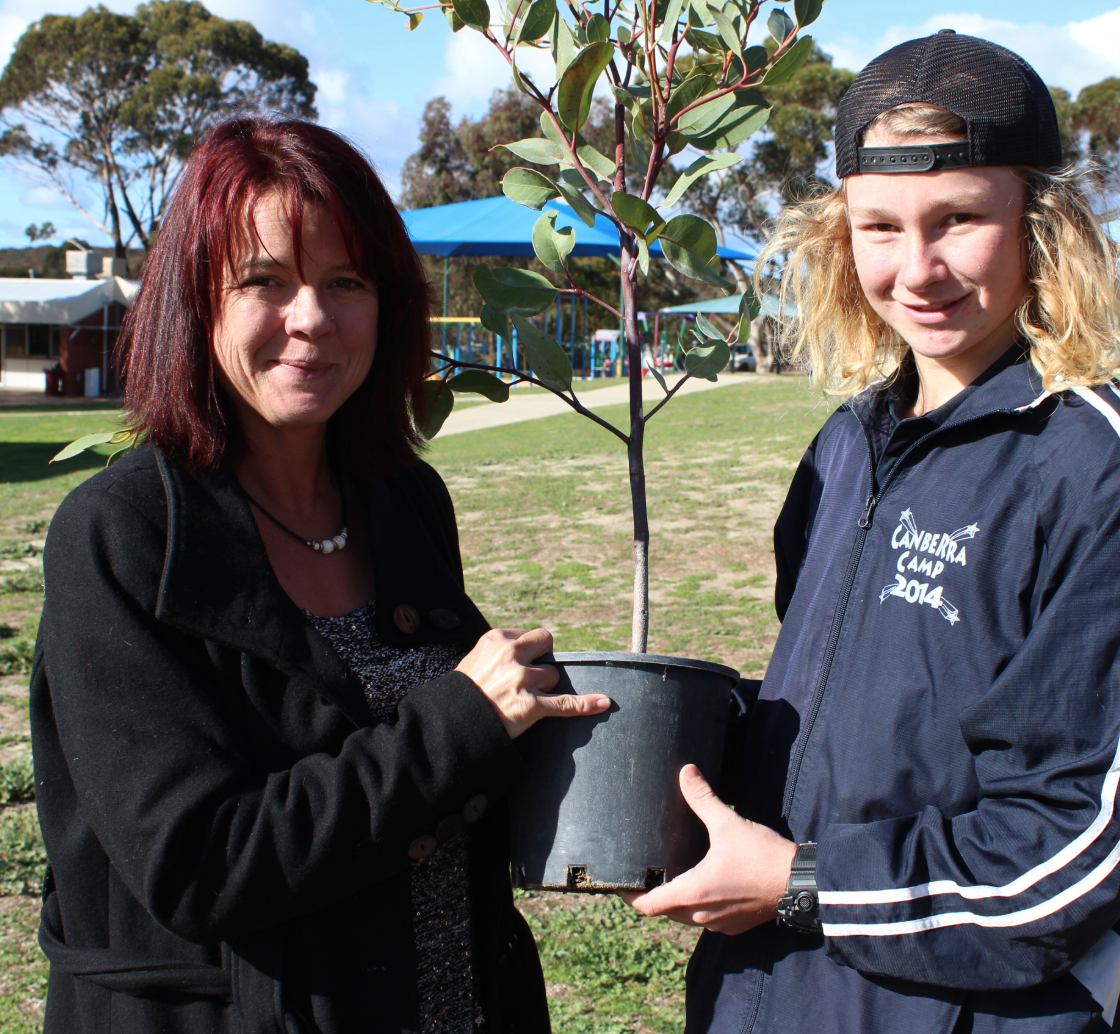National Tree Day 2019
DOROTHY HENDERSON
It’s a bright winter day in the small town of Ravensthorpe, in the south-east of Western Australia. There is a gentle commotion in the yard surrounding the school in the centre of the town, as a 4WD and a tidy trailer pulls up outside the school. The Ravensthorpe District High School gardener and community stalwart Don Green is there to greet Antoinette Vincent from Esperance Farm Trees.
Antoinette Vincent from Esperance Farms Trees with some of the native trees to go into the ground at Ravensthorpe School
An enthusiastic band of teenagers excitedly waits under the trees already shading the school yard, watching out for her and her cargo of native plants. The plants are destined for homes in the school ground. The mass planting marks this year’s National Tree Day, and also enables students to swap pens, pencils and text books for watering cans, hoses and gloves as they work together to get the saplings planted and ready to grow.
Since 1996, National Tree Day has been marked in Australia. It’s not a day that is celebrated with champagne or anniversary cake, but one which is made memorable by the number of trees left in the ground when it’s over. Sponsored by Toyota Australia, National Tree Day was co-founded in 1996 by Planet Ark and Olivia Newton-John. It’s Australia’s “largest community tree planting and natural protection event.”
With a rainfall deficit of at least 100mm in Ravensthorpe this season, moisture is lacking and the ground is hard. Most of the plants are carried to areas that will be kinder to the new arrivals. Luckily, both Antoinette and Don have augers to help drill into the ground; the prospect of digging the holes in some of the dried, more concrete like areas is a bit daunting.
There is a selection of special plants that should be at home in this red dirt, they have been chosen for this purpose and are suited to the soil type, climate and growing conditions in the town. Templetonias, westringias, banksias, kangaroo paws, hakeas and wattles are just some of the plants ferried to Ravensthorpe from Antoinette’s nursery.
Dominic Mantilla (15) and Shakira Bratten (15)
Within three hours, the bulk of the work is done. The small, cheerful band of students have laid out the plants, brightening and revitalising existing beds with carefully selected native species of different sizes and with different coloured leaves and flowers. Already the school grounds look like they’ve had a facelift and there’s lots of laughing and chatter as the students work to get the job done.
One of the students who helped organise the day laughs as she says that she was enjoying getting her hands dirty, and the outdoor work was “much better than triple maths and double science!”
Mr Green explains that the students at the school are encouraged to take part in activities that connect them with the natural world. Each year group has activities that tie the tree planting work to their academic tasks, and the tree planting exercise is a natural extension of programmes that already see students growing vegetables and herbs, with an extensive horticulture “department” including raised beds and an earthworm farm.
The tree planting in Ravensthorpe is one of many that has taken place throughout Australia as the nation recognises National Tree Day 2019. National School Tree day was officially on July 26, and National Tree Day on Sunday 28 July this year. The July dates are chosen by organisers as July is usually a planting time which is appropriate for most regions of Australia.
According to Planet Ark, over 25 million trees have been planted by over four million people as a result of National Tree Day activities.
In the lead up to this year’s Tree Days, Planet Ark urged people to take part, promoting the benefits of planting trees, both environmental and in human health terms.
Cited benefits included the fact that a 5% increase in tree cover can reduce nearby daytime temperatures by 2.3C, which could be crucial as heatwaves cost more lives than all other climate change impacts combined, and the impact on carbon absorption, with a large healthy tree able to sequester up to 93kg of CO2 and 1.4kg of air pollution a year
Then there is the knowledge that time spent in green outdoor spaces can lower the risk of heart disease and diabetes, while also reducing stress, improving happiness, wellbeing and productivity.
The energy and enthusiasm contained within the boundaries of the Ravensthorpe District High School as it celebrated National Tree Day was in itself evidence of the benefits of the day: children worked together in teams as they prepared planting sites; they talked to one another as they decided where the plants would go, and who was going to carry out what tasks, and the pleasure they gained from being outside was obvious in the smiles and from the sound of laughter in the air.
Gemma Price (14) and Shannon Hira (14)
Above Left - Jessie Bloomfield (14) and Namrin Kunawat (15) Above Right - Deli Jones and Kaleb Ebsary (16) taking part in the tree planting





